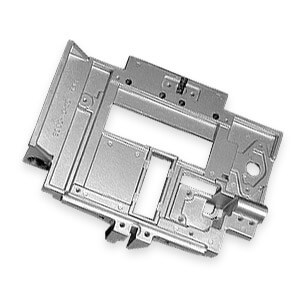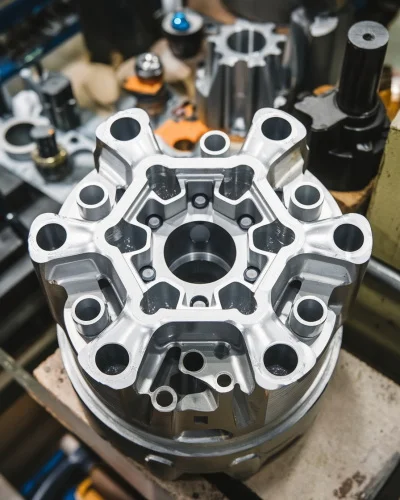How aluminum casting plays a major role in today’s manufacturing industry
Comprehending the Ecological Advantages of Aluminum Factory Techniques
Aluminum foundry methods play a necessary function in progressing sustainability within the manufacturing market. By executing sophisticated reusing approaches and energy-efficient practices, these strategies significantly minimize waste and carbon impacts. Innovative spreading methods even more enhance resource preservation initiatives. As sectors increasingly prioritize ecological obligation, understanding the complete impact of these techniques becomes crucial. What specific innovations are leading the means in this transformation?
The Function of Aluminum in Sustainable Production
Although numerous materials add to lasting manufacturing, light weight aluminum stands out due to its one-of-a-kind residential properties and recyclability. This lightweight metal is not only resilient however likewise has superb corrosion resistance, making it a suitable selection for different applications, from auto to construction. Its high strength-to-weight proportion causes energy savings during transportation and use. Light weight aluminum can be reused indefinitely without shedding its inherent qualities, advertising a round economy.
The production process of aluminum has actually progressed, incorporating energy-efficient techniques that minimize carbon footprints. By making use of renewable resource sources, manufacturers are significantly minimizing the ecological influence related to light weight aluminum production. Additionally, making use of recycled aluminum needs substantially less power contrasted to drawing out and fine-tuning main light weight aluminum, resulting in reduced greenhouse gas discharges. As markets seek lasting options, aluminum's convenience and environment-friendly qualities placement it as a crucial product in the quest of greener manufacturing practices.
Advanced Recycling Techniques in Aluminum Foundries
Advanced recycling methods in aluminum shops are reinventing the way scrap aluminum is refined and reused. Ingenious approaches, such as closed-loop recycling systems, allow factories to redeem light weight aluminum from production waste and out-of-date products successfully. These systems lessen worldly loss and enhance the high quality of recycled aluminum, making it a feasible choice to key light weight aluminum manufacturing.
Additionally, progressed arranging innovations, consisting of automated optical sorting and X-ray fluorescence, enhance the splitting up of aluminum from other materials, guaranteeing higher pureness degrees in recycled outputs. This precision lowers contamination, which can compromise the integrity of the end product.
In addition, the assimilation of sophisticated melting modern technologies, such as induction melting and energy-efficient furnaces, enhances the reusing procedure, reducing energy consumption. Collectively, these innovations add to an extra lasting aluminum industry by minimizing dependence on virgin materials and lowering greenhouse gas exhausts connected with aluminum production.
Power Effectiveness Improvements in Shop Workflow
Energy effectiveness enhancements in aluminum factory operations can significantly improve sustainability methods. Carrying out waste warmth healing systems permits factories to repurpose excess energy, reducing overall power consumption. In addition, advancements in procedure automation streamline operations, leading to minimized waste and maximized resource use.
Waste Warmth Healing
Executing waste warm recovery systems in aluminum foundries substantially boosts power effectiveness by catching and reusing excess thermal energy produced during manufacturing procedures. These systems assist in the conversion of wasted heat into usable energy, which can be made use of for various applications within the shop, such as powering or preheating products tools. By recovering warm that would certainly otherwise be expelled into the environment, shops can substantially decrease their general energy intake and greenhouse gas exhausts. This technique not only lowers operational costs however likewise promotes lasting practices within the market. In addition, the adoption of waste warm recuperation innovations straightens with regulatory requirements focused on decreasing ecological effect, making it an important component of modern aluminum shop operations.
Refine Automation Conveniences
Automating processes in light weight aluminum foundries can significantly boost energy performance by enhancing manufacturing workflows and lowering waste. By executing innovative innovations such as robotics and maker knowing, foundries can improve operations, lessening unneeded power usage. Automated systems promote accurate control over temperature level and product handling, making sure that power is used only when needed. Furthermore, real-time tracking allows for immediate adjustments, decreasing the threat of energy loss. The assimilation of automation not just improves productivity but additionally lowers operational costs, making factories extra competitive. Therefore, these energy-efficient methods contribute substantially to sustainability objectives, reducing the environmental footprint of aluminum production while meeting enhancing market demands - Precision aluminum casting. Boosted power efficiency with automation represents an essential action towards greener foundry procedures
Lowering Waste With Ingenious Casting Methods
Innovative spreading methods play an essential role in reducing waste in aluminum foundries. Strategies such as advanced molding and the usage of recyclable products substantially decrease production scrap. These techniques not only boost effectiveness yet likewise contribute to a much more lasting production procedure.
Advanced Molding Techniques
As markets progressively prioritize sustainability, advanced molding strategies in light weight aluminum foundries become efficient remedies for decreasing waste. These cutting-edge techniques, such as 3D printing and accuracy mold and mildew making, significantly enhance the performance of the spreading procedure. By utilizing computer-aided layout (CAD) and simulation modern technologies, makers can optimize mold geometry, decreasing material use while maintaining item honesty. Furthermore, progressed techniques make it possible for the manufacturing of complicated shapes that traditional approaches can not achieve, decreasing the demand for added machining and thereby reducing scrap product. The flexibility of these strategies allows for quick prototyping, more reducing preparations and energy consumption. Generally, the execution of advanced molding methods represents an essential action towards ecologically responsible light weight aluminum manufacturing, straightening with international sustainability goals.
Recyclable Product Application
Recyclable materials play a pivotal duty in decreasing waste within light weight aluminum shops, transforming the casting landscape with their reliable usage. By incorporating scrap aluminum and various other recyclable components right into the manufacturing process, factories can considerably decrease the demand for virgin materials. This not just saves natural deposits however likewise reduces power consumption associated with mining and refining. Innovative spreading approaches, such as die spreading and sand casting, enable smooth integration of these products, making sure high-grade outputs. Additionally, the usage of recyclable materials cultivates a circular economy, where resources are continually reused and repurposed, minimizing garbage dump contributions. Ultimately, the critical usage of recyclables enhances sustainability while promoting cost-effectiveness in aluminum foundry procedures.
Lessening Production Scrap

Life Process Evaluation of Light Weight Aluminum Products
Although aluminum is extensively recognized for its resilient and light-weight residential properties, a comprehensive Life Cycle Evaluation (LCA) discloses the environmental influences connected with its usage, disposal, and production. The LCA procedure checks out the energy intake, greenhouse gas exhausts, and source deficiency connected to light weight aluminum items from removal of bauxite ore to end-of-life management. Main aluminum manufacturing is energy-intensive, frequently relying upon nonrenewable fuel sources, which adds substantially to carbon footprints. On the other hand, recycling aluminum uses substantial ecological advantages, as it makes use of just a portion of the power needed for primary manufacturing. The recycling process minimizes land fill waste and preserves natural resources. The LCA also thinks about the item's durability and capacity for reuse, emphasizing the value of lasting style. In general, recognizing the life process effects of aluminum items is vital for making educated decisions that focus on ecological sustainability within the industry.
Instance Researches: Effective Sustainable Practices in the Industry
The aluminum market has begun to welcome innovative lasting methods that address the environmental obstacles determined in Life Cycle Assessments. One remarkable instance is a leading foundry that executed a closed-loop recycling system, substantially lowering waste and power intake. By reusing scrap aluminum in production, the facility accomplished a 40% reduction in its carbon footprint.
Another instance involves a producer that embraced renewable resource resources, powering its operations with solar and wind power - Aluminum Casting Company. This shift not just lowered greenhouse gas exhausts but also enhanced the business's reputation amongst eco mindful customers
Furthermore, a third factory has actually invested in sophisticated casting techniques, which maximize material usage and lessen problems, additionally decreasing source consumption. These case researches illustrate that the light weight aluminum industry can integrating lasting practices, showing both environmental duty and economic feasibility, eventually contributing to a much more lasting future.
Frequently Asked Inquiries
How Does Aluminum Contrast to Various Other Metals in Sustainability?
Light weight aluminum is typically considered a lot more sustainable than numerous steels due to its recyclability, reduced power demands for production, and reduced ecological effect. Its lifecycle performance exceeds that of steel and copper in various applications.
What Is the Carbon Impact of Light Weight Aluminum Shop Processes?
The carbon footprint of aluminum foundry processes varies, normally ranging from 4 to 15 metric lots of carbon dioxide per heap of aluminum generated. Variables affecting this include power resources, modern technology, and the efficiency of procedures.
Are There Wellness Dangers Related To Aluminum Shop Operations?

What Are the Expenses Connected With Sustainable Light Weight Aluminum Techniques?
The expenses related to lasting aluminum strategies include greater first financial investments in modern technology, prospective boosts in operational costs, and recurring upkeep. However, these are typically offset by lasting financial savings and minimized environmental influence.
How Does Aluminum Recycling Impact Citizen Communities?
Light weight aluminum reusing positively influences regional communities by creating work, decreasing landfill waste, and decreasing energy expenses. It promotes economic growth and promotes ecological stewardship, causing much healthier living conditions and boosted check over here community engagement in sustainability initiatives.
Additionally, the usage of recycled aluminum requires considerably much less power compared to drawing out and fine-tuning primary light weight aluminum, leading to reduced greenhouse gas emissions. Advanced recycling techniques in aluminum foundries are revolutionizing the means scrap light weight aluminum is processed and reused. Aluminum Foundry. Carrying out waste warmth healing systems in light weight aluminum foundries significantly improves energy effectiveness by recording and reusing excess thermal energy generated during manufacturing procedures. Automating procedures in light weight aluminum foundries can greatly improve power efficiency by enhancing production workflows and decreasing waste. The carbon footprint of aluminum shop procedures differs, typically varying from 4 to 15 metric loads of Carbon dioxide per ton of aluminum created